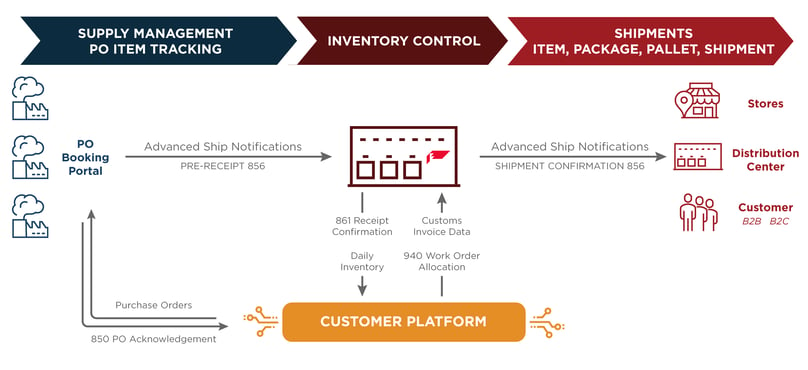Grow your international business, improve margins, delight your customers, lower lead times, and reduce carbon output. Sounds almost too hard to achieve? Well, good news! There are supply chain fulfillment models that can accomplish all of these important goals.
Upstream Fulfillment is a program that enables the movement of goods from point of supply directly to the point of sale or consumption without transiting through your distribution centers (DC) where allocation, consolidation, and customer value-added localization typically occur.
In many supply chains, servicing your distributors or international channels involves a complicated orchestration of managing ex-factory ready dates, customer turnover points, and local carrier bookings. On top of that, you're trying to maximize your customers’ shipment consolidations with products sourced from multiple suppliers. Often, to provide a seamless experience to their customers, organizations move products into their pre-existing DC networks. However, this process adds transportation costs and extends lead-times.
In efforts to improve speed to market, retailers and non-retailers alike, are increasingly allocating merchandise before it is exported from the country or region of manufacture. Upstream Fulfillment supports this innovative flow model and enables companies to ship directly to DCs, stores, or consumers, as well as multi-channel fulfillment to their international markets, distributors, and franchise partners.
How can you benefit from this program?
Implementing an Upstream Fulfillment site close to your supplier base offers many opportunities:
- Improve service experience to customers with a single pick-up location and easing minimum order quantity (MOQ) constraints
- Avoid re-handling costs and stock transfers of merchandise between distribution facilities
- Reduce overall lead times to stores and global customers
- Reduce environmental impact through fewer "product miles"
- Perform quality inspection close to the manufacturing origin with our established platform
- Relieve pressure on existing DC infrastructure in higher cost fulfillment regions
- Alleviate supplier dependence while building supply chain agility
- Improve revenue recognition processes and timeliness
- Reduce administrative work and cash flow impacts through the elimination of duty drawback needs and processes
How does Upstream Fulfillment work?
- Supplier Pick-up/Drop-off
To integrate an Upstream Fulfillment strategy, organizations may choose a cross-dock or inventory location at an optimized site supporting local and regional suppliers. Often, these sites are bonded or free trade zone areas that allow for suppliers to obtain tax refunds upon “export” or turnover to the bonded zone. This is an important piece of the Upstream Fulfillment process as it mirrors the current factory processes of exporting products upon production completion.
- Order Allocation and Fulfillment
The purchase order quantities received in the site may be already allocated for a given destination, or may arrive at the facility unallocated and supply may be aligned with the appropriate demand channel. This flexibility provides your customers with faster lead times. They will also have the ability to procure a larger assortment of products than they may have previously when constrained by MOQs and individual supplier pick-up points – factors that contribute to potentially greater sales penetration.Based on the scope of work required and the specific channels fulfilled, inspection processes or value-added labeling, kitting, and ticketing activities may be completed. For channels moving directly to the customer with small pack couriers, individual carton labeling for injection into destination courier networks may be performed.
- Carrier Coordination and Documentation
Once orders have been received and/or fulfilled completely, in addition to receiving the authorization to release, products are staged ready to ship, and the appropriate carriers are notified for freight delivery. To protect the confidential supplier information and to reflect the new consolidated shipment contents, a new shipping invoice is prepared to accompany the customer order. Freight moves according to the approved mode, service level, and nominated carrier in the transaction. These shipments may be distributor turnovers, in-country DC replenishment, direct to store shipments, or other direct import programs that can bypass destination DCs. - Systems Connectivity and Visibility
A variety of best-practice systems configurations are possible based on program needs. The process normally begins with the communication of the original Purchase Order to the supplier and extends through the fulfillment and documentation process. The suppliers can book freight into the Upstream Fulfillment center where inventory receipt is confirmed at the site. Orders are allocated to the specific fulfillment channels, document data is shared, and revenue recognition is completed upon turnover and shipment confirmation.

The upstream fulfillment model enables organizations to move their fulfillment nodes anywhere their customers or supplier base requires, providing efficient, agile, and compliant capabilities globally.
Upstream Fulfillment simplifies your distribution strategy while creating capacity in your DC network to focus on core fulfillment activities for the brand. The key advantage of Upstream Fulfillment is it allows you to avoid using resources to process orders in sites where the products will not be sold. While e-commerce volumes surge and the space within DCs close to consumer markets is at a premium, you do not have to let the activities of your international channels disrupt your core focus.
Be sure to stay tuned for our Upstream Fulfillment FAQ series! Next week we'll be going over frequently asked questions on how to avoid logistics inefficiencies in your supply chain.




